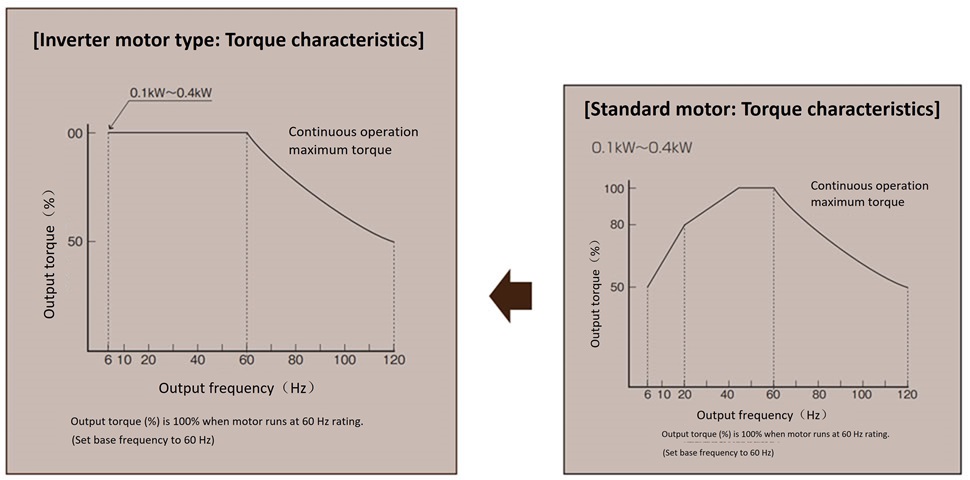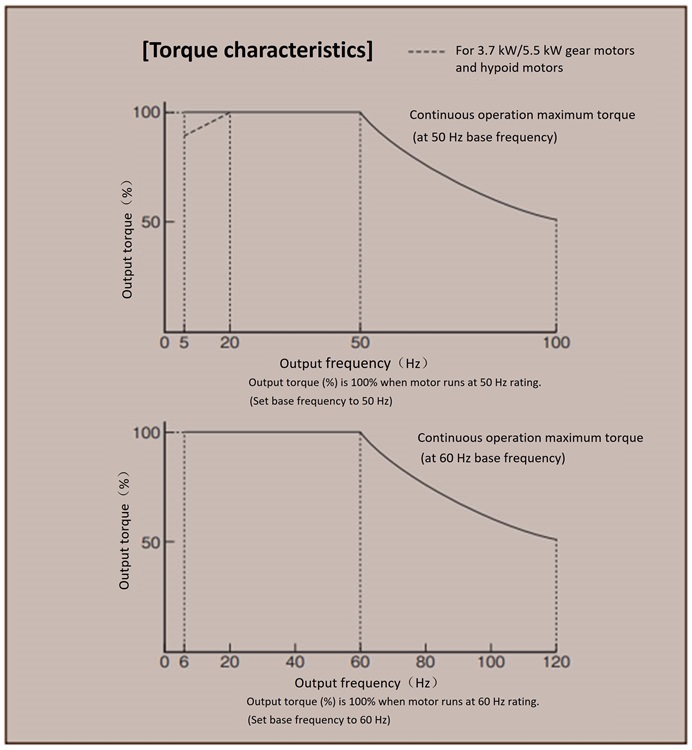Technical Data Reducers Small-Size Gear Motor Motor Specifications
When a Standard Motor Is Continuously Inverter-Driven
1. Frequency range
- ・Maximum 120 Hz. In the low-Hz range (low frequency), use within the allowable range of the inverter.
- ・40/60/90 W models cannot be used in the low-frequency range and at continuous operation of 60 Hz or higher. Consult us separately.
- ・The 0.75 kW to 5.5 kW IE3 motors can be operated at constant torque between 6 Hz to 60 Hz. For details, please refer to the section below on continuous inverter drive of IE3 motor.
2. Torque characteristics
For the frequency and torque characteristics, refer to the following graphs.
- ・At high speeds, torque decreases inversely in proportion to the rotation speed because the power becomes constant at kW. In addition, as the rotation speed increases, motor noise, motor fan noise, reduction gear noise, and vibrations also increase.
- ・At low speeds, the operating and cooling efficiency of the motor decreases, so temperature raises. Use with a lower torque as shown below.

3. Brake type
- ・The brake circuit must be operated individually due to its required power supply. Standard products are shipped with the brake lead wire screwed together with the motor lead wire. The brake lead wire should be unscrewed and connected individually.
- ・Perform braking at 60 Hz (1800 r/min) or less speed. Braking at high speed range over 60 Hz may cause mechanical damages, and heating and wear on lining. Make sure to operate at 60 Hz or lower frequency.
4. For single-phase motors and explosion-proof motors
- Because the single-phase motor uses a capacitor, inverter drive is not available.
Inverter drive is also not available for the explosion-proof motor because it is not covered by the applicable power supply (frequency, voltage) for explosion-proof testing.
5. Notes
When using a motor with a low frequency or with a frequency of 60 Hz or higher, lower the torque as shown in the graphs above.
- ・When using inverter drive with a 400 V-class motor, dielectric breakdown may occur due to a high-voltage surge (micro surge) that occurs with switching of the inverter. Countermeasures are therefore needed for the motor (micro surge protection). Standard 400 V-class-and-higher motors come standard with micro surge protection. However, with levels in excess of 1250 V, a suppression filter or reactor should be installed on the inverter side.
- ・Compared with standard power supplies, the inverter drive is greater increases in temperature, noise, and vibration should be expected.
- ・To protect the motor from overheating, use an electronic thermal mechanism configured to general-purpose motor characteristics, or use a thermal relay or other device between the inverter and the motor.
- ・When using at a base frequency of 50 Hz, set the output torque to 0.8 times that in the chart above. (For 0.1 kW to 0.4 kW models only. )
※Inverter motor type
For 0.1 kW to 0.4 kW models, the inverter motor type is available as an option.
With variable frequency driven motor [Option symbol :Z、ZV]
Motors used exclusively for inverters and can be run in constant torque in the range of 6 Hz to 60 Hz during inverter driving.
Compatible capacity :0.1kW~0.4kW Ship with standard motor mounted.

| Series | Voltage | Code | Motor Capacity | ||
|---|---|---|---|---|---|
| 0.1kW | 0.2kW | 0.4kW | |||
| Gear Motor Hypoid Motor Croise Motor |
200 VAC class | Z | ○ | ○ | ○ |
| 400 VAC class | ZV | ○ | ○ | ○ | |
Note) Rated Voltage [0.1kW~0.4kW:200 VAC class =200/220V 60Hz、400 VAC class =400/440V 60Hz]
Precautions
- ・At frequencies of 60 Hz to 120 Hz, as with the standard motor, there is a characteristic zone with constant horsepower and limited output torque. Care should therefore be taken with the load torque.
- ・Be sure to adjust the output voltage of the inverter so that the input voltage from the inverter to the motor conforms to the voltage and frequency indicated on the nameplate. (In the case of inverter motors, the base frequency must be 60 Hz. ) In addition, do not directly connect the inverter motor without an inverter because doing so will result in drastic current increases due to voltage changes. (except in cases of operation for only a short time, such as test runs or emergency runs )This phenomenon occurs frequently at 50 Hz.
- ・Be sure to set the base frequency of the inverter at 60 Hz.
- ・If 100% torque is required at low frequencies, apply a torque boost with the inverter as necessary. Continuous operation for a long time with too much torque boost applied will cause overheating, and should be avoided.
- ・The motor may resonate depending on the revolution speed and frequency. When operating continuously, avoid the resonance frequency by, for example, changing the carrier frequency setting of the inverter.
- ・When the load is low, for example, at the time of a trial run, the current may become large at low frequencies. This is due to motor characteristics and does not indicate an abnormal condition. It is possible to decrease the current by changing the setting of the inverter (reducing the torque boost, reducing the V/F ratio, and/or adjusting the torque vector).
- ・To protect the motor from overheating, use an electronic thermal relay set to general-use motor specifications, or install a thermal relay between the inverter and the motor.
- ・For brake-equipped models, refer to the wiring diagram. Braking at high frequencies, above 60 Hz, may cause mechanical damage or excessive wear on the lining of the brake.
When an IE3 Motor Is Continuously Inverter-Driven
Compatible capacity :0.75kW~5.5kW IE3 motor
1. Torque characteristics
For the frequency and torque characteristics, refer to the graphs to the right.
- ・At high speeds, torque decreases inversely in proportion to the rotation speed because the power becomes constant at kW. In addition, as the rotation speed increases, motor noise, motor fan noise, reduction gear noise, and vibrations also increase.
- ・At low speeds, the operating and cooling efficiency of the motor decreases, so temperature raises.
2.Brake type
- ・The brake circuit must be operated individually due to its required power supply. Standard products are shipped with the brake lead wire screwed together with the motor lead wire. The brake lead wire should be unscrewed and connected individually.
- ・Perform braking at 60 Hz (1800 r/min) or less speed.
Braking at high speed range over 60 Hz may cause mechanical damages, and heating and wear on lining. Make sure to operate at 60 Hz or lower frequency.

3. Notes
- ・At frequencies of 60 Hz to 120 Hz at a base frequency of 60 Hz, and frequencies of 50 Hz to 100 Hz at a base frequency of 50 Hz, as with the standard motor, there is a characteristic zone with constant horsepower and limited output torque. Care should therefore be taken with the load torque.
- ・Be sure to adjust the output voltage of the inverter so that the input voltage from the inverter to the motor conforms to the voltage and frequency indicated on the nameplate.
- ・If 100% torque is required at low frequencies, apply a torque boost with the inverter as necessary. Continuous operation for a long time with too much torque boost applied will cause overheating, and should be avoided.
- ・The motor may resonate depending on the revolution speed and frequency. When operating continuously, avoid the resonance frequency by, for example, changing the carrier frequency setting of the inverter.
- ・When the load is low, for example, at the time of a trial run, the current may become large at low frequencies. This is due to motor characteristics and does not indicate an abnormal condition. It is possible to decrease the current by changing the setting of the inverter (reducing the torque boost, reducing the V/F ratio, and/or adjusting the torque vector).
- ・In order to prevent the motor from overheating, use an electronic thermal relay between the inverter and motor.
- ・When using inverter drive with a 400 V-class motor, dielectric breakdown may occur due to a high-voltage surge (micro surge) that occurs with switching of the inverter. Countermeasures are therefore needed for the motor (micro surge protection). Standard 400 V-class-and-higher motors come standard with micro surge protection. However, with levels in excess of 1250 V, a suppression filter or reactor should be installed on the inverter side.
- ・Compared with standard power supplies, the inverter drive is greater increases in temperature, noise, and vibration should be expected.

